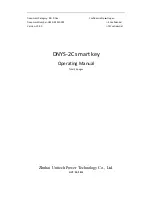
CR46
8
• When servicing the machine, place it on a level sur-
face and ensure that it cannot be moved.
• Observe the service intervals and annual safety
inspections.
• All spare parts and equipment must fulfill the
manufacturer’s requirements. This can be guaran-
teed by using original parts.
• Put all safety devices back into place immediately
once servicing or maintenance is complete.
When lifting the machine, check
that the lifting/hoisting equip-
ment is in perfect working order.
Check the weight of the machine
before lifting it. Choose lifting
trajectories so that they do not
cause any danger.
Many countries have specific legislation on lifting, hois-
ting cables and hoists. Always comply with local safety
regulations.
OILS AND LUBRICATION
• Always use the oil types recommended by the
manufacturer. Other types of oil may cause
faults or improper operation of the equipment,
which could lead to serious damage to people or
property.
• Never mix different liquids or oils.
• Always follow the manufacturer’s lubrication
instructions.
• Use control equipment carefully until the hydraulic
oil has had time to reach its operating temperature.
SAFETY INSTRUCTIONS FOR HYDRAULIC CIRCUITS
1. Work on hydraulic equipment may only be
carried out by professional hydraulic engineers.
2. Be cautious when using the equipment in cold con-
ditions.
3. Check the machine for leaks. Do not use the
machine if there is a leak from any system. Check all
hydraulic hoses – particularly those which are bent
during use – and replace any that are in poor con-
dition or have leaks. Ensure that all joins are tight
and that the lines are not damaged. Check that all
protective caps and filler caps are closed properly.
Check the hose sheathing for damage.
4. Check that all hose connectors, lengths and
qualities comply with applicable requirements.
When replacing or repairing hoses, use original
parts or hoses and connectors recommended
by the manufacturer. Check particularly that the
pressure classes of the hoses and connectors are
suitable to the operating pressure levels.
5. Check that all safety devices such as pressure
relief valves, etc., are in place and work properly.
Familiarize yourself with their use. Safety systems
may never be bypassed.
6. Check the main hydraulic parts daily, and always
after a fault. Replace any damaged parts imme-
diately.
7. If a component is damaged, clean it before re-
pairing it. Do not use solvents when cleaning parts.
8. Do not attempt to carry out repairs that you are
not fully familiar with.
9. Never carry out repairs of the hydraulic circuit
when the system is pressurized. When pressurized,
the oil spray can penetrate the skin and cause mor-
tal danger.
10. Never work below a device or component that is
only being held up by hydraulics. Use separate sup-
ports when carrying our maintenance or repairs.
Do not disconnect cylinders or their valves until the
machine is well supported.
11. Most hydraulic oils do not evaporate easily. Risk
factors include hot oil, spills and oil mist (pressu-
rized).
12. If oil gets into your eyes, rinse with plenty of water
and contact a doctor.
13. Avoid prolonged or repeated contact with your
skin.
14. If sprays or contact with the skin cannot be avoided,
use protective gloves, goggles and clothing as
necessary. Do not use oily clothing.
CAUTION!
!
Summary of Contents for CR46
Page 2: ...CR46 2 ...
Page 29: ...CR46 29 ...
Page 34: ...CR46 34 1 9 8 7 6 5 4 3 2 2 7 200001637 LIFTING BOOM ...
Page 38: ...CR46 38 1 10 8 7 6 5 4 3 2 11 16 15 14 13 12 14 13 13 15 9 200002614 ROTATOR CR404S W25A30 ...
Page 43: ...CR46 43 ...
Page 48: ...CR46 48 ...
Page 51: ......









































